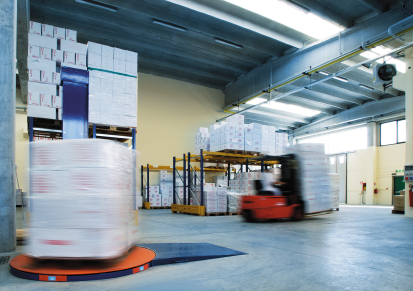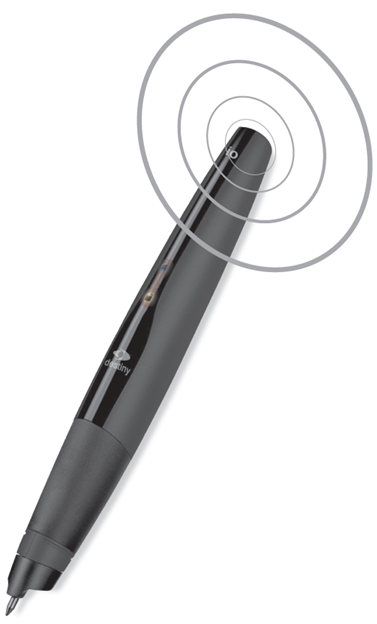 The Health and Safety Executive (HSE) report that over £512 million a year is the cost to UK businesses for major injuries. As the HSE explain “Legal actions brought as a result of an injury can be extremely damaging to business…..(and) insurance covers only a small proportion of the costs.” So in a warehouse environment with storage, transport and many operational dangers it is imperative to ensure training, risk assessment and health and safety compliance. But how efficient are traditional manual warehouse processes for checking that training and risk assessments have been carried out, are complete and being applied effectively? Can a digital pen improve both efficiency and effectiveness in a warehouse environment?
The Health and Safety Executive (HSE) report that over £512 million a year is the cost to UK businesses for major injuries. As the HSE explain “Legal actions brought as a result of an injury can be extremely damaging to business…..(and) insurance covers only a small proportion of the costs.” So in a warehouse environment with storage, transport and many operational dangers it is imperative to ensure training, risk assessment and health and safety compliance. But how efficient are traditional manual warehouse processes for checking that training and risk assessments have been carried out, are complete and being applied effectively? Can a digital pen improve both efficiency and effectiveness in a warehouse environment?
First a word on digital pens in warehousing
A digital pen allows the recording of written information both in traditional ink/paper and modern electronic formats. Personnel can carry digital pens around as they are lightweight and durable, can be used anywhere a normal pen would be and yet can supplement other warehouse system processes by connecting to a phone, laptop or computer.
Health & safety in warehousing
There are numerous acts and legislation where businesses must demonstrate compliance including:
- The Health and Safety at Work etc Act 1974 (HSWA) requiring employers to ensure the health and safety of all employees and anyone who may be affected by their work. Employees must not endanger themselves or others and must use any safety equipment provided. Manufacturers and suppliers have a duty to ensure that their products are safe. They must also provide adequate information about appropriate use.
- The Management of Health and Safety at Work Regulations 1999 builds on HSWA and includes duties on employers to assess risks and where necessary take action to safeguard health and safety.
- The Workplace (Health, Safety and Welfare) Regulations 1992 require floors to be suitable, in good condition and free from obstructions. People must be able to move around safely
- Management of Health & Safety at Work Regulations 1999 (MHSWR)
- Reporting of Injuries Diseases and Dangerous Occurrence Regulations (RIDDOR)
- The Provision and Use of Work Equipment Regulations 1998 (PUWER)
- The Lifting Operations and Lifting Equipment Regulations 1998
- INDG 199 Managing Vehicle Safety at the Workplace
Compliance with the above legislation requires:
- Routine and up to date risk assessments
- Briefings to team members
- Education and training to all personnel during induction, developmental and on an on-going or ad hoc basis
With large numbers of personnel within a warehouse, new joins, temporary staff and contractors that come and go, how fast, accurate and time consuming is the tracking, scanning, photocopying, word processor and spreadsheet typing of the vast mountain of paperwork for:
- Risk assessments
- Health and safety inspections
- Briefing or site attendances
- Training signatures and training forms
- Accident form filing
- Cross reference filing indexes?
All this can be very time consuming and sometimes slow and inaccurate work. So rather than adding to the administrative burden a digital pen can:
- Capture risk assessment, signature and other written information and turn it into electronic format almost instantly and then store the documents immediately and quickly without manual filing
- Automatically distribute signed forms and notes electronically to reduce creating copies
- Contain drawings and photographs (for the latter a digital pen must work with a smart phone or equivalent, with a camera) for greater accuracy
- Have the capacity to automatically link notes and completed forms to electronic filing systems and databases for fast and accurate storage and retrieval
In an operational environment it is sometimes easier to take notes in a book, draw a diagram on paper to explain or understand a point, or have a larger space to record information (compared to a small smart phone, PDA or data capture device screen) and this is where a digital pen is extremely useful. Yet at the same time a digital pen can link to back end office or warehouse systems immediately in order to streamline operational processes, ensure paperwork isn’t lost and that extra administration isn’t created.
Warehouse training
Personnel require up to date training in both legislation and work duties. Again this covers many areas, for example:
- Driving Tests for vans, rigid trucks and articulated trucks
- Certification for lift trucks used by warehouse operative staff as required by the Health and Safety Executive
- The Certificate of Professional Competence for Transport Operators as required by an EU Directive, as part of the licensing process for operators of goods vehicle fleets (‘O’ Licensing)
- HSE legal requirements as seen above
- Handling and transportation of dangerous goods
- NVQ certification
- Local operating procedure knowledge and competence
- Good manufacturing practice, etc.
Local operating procedures and NVQ assessment can include operational areas such as:
- Driving vehicles and lift trucks
- Carrying and delivering goods
- Traffic office work
- Storage and warehousing operations
- Mail services
 In many of these areas both daily duties and training assessment competence often include lots of paperwork since digital assessment and recording is not always possible or practical. Take for instance a competency based work assessment, that can include the observation of real or simulated work processes using workplace procedures and questioning, often being demonstrated in an actual or simulated work situation under supervision. Recording information here needs to be accurate, fast and cross reference other work based learning areas, yet all this can be achieved with a digital pen. For example if moving goods is being assessed, then to make the best use of time, a digital pen can help capture evidence for this assessment plus other training areas or procedures such as health and safety, manual handling, stock keeping or security. Using digital pens, note pads and paper forms in this environment speeds up data capture and administration where using small screen computer based equipment, PDAs, phones or PCs can be extremely difficult or not cost effective to use.
In many of these areas both daily duties and training assessment competence often include lots of paperwork since digital assessment and recording is not always possible or practical. Take for instance a competency based work assessment, that can include the observation of real or simulated work processes using workplace procedures and questioning, often being demonstrated in an actual or simulated work situation under supervision. Recording information here needs to be accurate, fast and cross reference other work based learning areas, yet all this can be achieved with a digital pen. For example if moving goods is being assessed, then to make the best use of time, a digital pen can help capture evidence for this assessment plus other training areas or procedures such as health and safety, manual handling, stock keeping or security. Using digital pens, note pads and paper forms in this environment speeds up data capture and administration where using small screen computer based equipment, PDAs, phones or PCs can be extremely difficult or not cost effective to use.
There are other work based assessment methods and areas where digital pens can be effectively used too:
- Questioning – where answers to oral questions are recorded as trainees perform work duties, possibly under observation
- Short written answer questions or multiple choice
- Professional discussion
- Writing witness statements
- Photographic evidence
- Product evidence e.g. where despatch or other documents are produced and used with digital pens e.g. proof of collection or proof of delivery
- Personal statements – where the trainee accounts for why they did an activity in a certain way or how they produced a product of their work e.g. handling a customer complaint
Recorded evidence can be:
- Captured by digital pen and paper
- Automatically emailed immediately
- Verified online
- Linked to back end office systems such as electronic training record cards, training folders, individual portfolios and quality assurance and training databases
Locating documentation immediately
If documentation cannot be found, or is later “discovered” to be incomplete then you run the risk of not being able to show legal or internal compliance, or internal/third party evidence verification. So quality assurance (QA) warehouse software and procedures is critical and a digital pen can aid here, by helping build accessible and easy to locate documentation. Simple QA in a warehouse using a digital pen can include more than just training and education, for example:
- Providing support to colleagues to check that health, safety, and security procedures are followed at all times and recording incidents
- Recording where personal protective equipment is not used correctly or at all, when it should be
- Identifying, recording and actioning promptly any health and safety hazards and any security issues
- Completing daily and ad hoc lift truck and vehicle safety checks
- Taking immediate action to prevent injury, theft, or damage, and give priority to the protection of people over organisational performance, then recording these incidents
- Responding to incidents affecting health, safety, and security by using the appropriate safety equipment and carrying out and recording against the safety procedures specified by the organisation
- Report accidents and emergencies to the appropriate people and ensure they are recorded in the appropriate electronic and manual information systems
The digital pen can be carried anywhere around a warehouse, transportation or planning office and can be used with pre-defined forms, note books and warehouse management system paperwork e.g. despatch notes. This enables faster and easier location of all warehouse documentation.
Understanding training requirements
Having timely and accurate access to pen and paper recorded training records is also essential to understand key pieces of management information. For example knowing that all health and safety induction training is complete in a warehouse or across a number of units. Or for example where refresher training relating to health and safety is required. Here a digital pen solution can help as data from both health and safety or other forms and training documents can be captured, combined and linked electronically in back end office systems. So taking fork lift truck training for example, in addition to routine monitoring and time tabled training, formal re-assessment is likely needed where personnel:
- Have not used trucks for some time
- Are occasional users
- Appear to have developed unsafe working practices
- Had an accident, or a near miss
- Have a change to their working practices or environment
Information collected using digital pens help build health and safety records, risk assessments, re-training requirements and store this information safely, with easy access. Using Juniper Innovations’ back end office integration and software solutions this information can viewed and managed easily within a company.
Where else is a digital pen useful as a warehouse system solution?
 Digital pens can be used any where in office or operational environment, internal, third party or customer meetings or for project work. Writing, drawings, coloured lines, bar code, signatures and even GPS data can be recorded and immediately distributed to email lists, web servers and back end office system databases. Plus signature capture can be used in a play back mode using the digital pen software to authenticate and prove not only that the signature was made, but also the style of writing used to create it thus helping to show the style of handwriting for stronger authentication proof.
Digital pens can be used any where in office or operational environment, internal, third party or customer meetings or for project work. Writing, drawings, coloured lines, bar code, signatures and even GPS data can be recorded and immediately distributed to email lists, web servers and back end office system databases. Plus signature capture can be used in a play back mode using the digital pen software to authenticate and prove not only that the signature was made, but also the style of writing used to create it thus helping to show the style of handwriting for stronger authentication proof.
A digital pen can also work hand in hand with other data capture devices however it gives personnel options on how to capture and record information, plus digital pens are:
-
Low cost compared to other data capture devices
-
Have a long battery life
-
Can be used even when the ink runs dry (ink cartridges are available)
-
Requires very little training
-
Does not require major support from your IT department or require frequent software updates
All in all digital pens can improve efficiency and effectiveness within a warehouse adding value to warehouse systems and processes.
